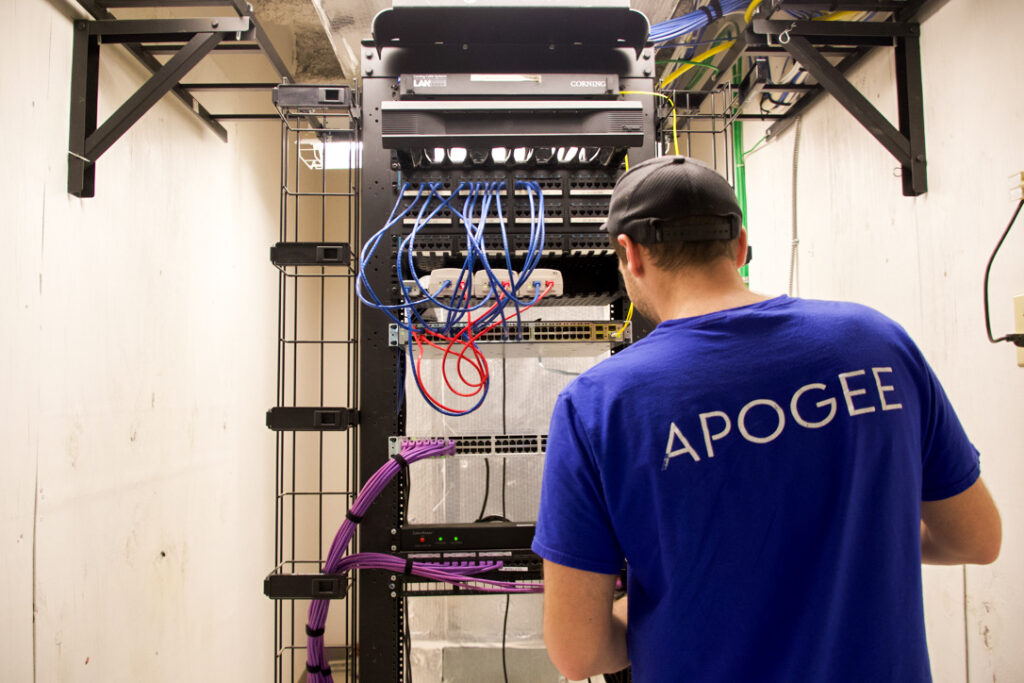UMW updates APOGEE Wi-Fi network for faster internet speed and equipment upgrade, causing outages in halls
4 min read
MyResNnet-5G will have faster internet speeds and sustain up to eight devices. | Abbey Magnet, The Weekly Ringer
by SOPHIA TOMPKINS
Staff Writer
On Feb. 13, UMW began upgrading the APOGEE Wi-Fi network, as they are due for a periodic equipment upgrade of their services in residence halls. After completing background work and testing, the update started in Virginia Hall on Feb. 19.
APOGEE is the residential network on campus for wired and wireless internet access as well as cable TV. Students who live on campus can stay on this network when they leave their dorm through a wireless connection.
The upgrade entails the installation of a new MyResNet network in each residence hall and promises faster internet speeds and the ability to sustain eight devices on the network at the same time.
According to the UMW website about the upgrade, “Residents will have a user-based personal area network (PAN) and can connect wireless printers, gamer devices and IoT devices, and these devices should be able to see each other, just like a home network.”
Chief Information Officer Hall Cheshire said the update is going as planned. According to UMW’s website, the updates are expected until March 10. In the meantime, students will receive email notifications regarding when updates will take place in their building, and students can expect Wi-Fi outages while the updates are being completed in their residential halls.
In light of these expected outages, students have been given temporary access to a guest portal for periods of six hours for faster internet speeds. There are also informational handouts posted in residential halls with instructions on how to connect.
When the upgrade is complete, students will have to create a login through a new portal to connect to the upgraded network, and they may use their single sign-on login information with their NetID and corresponding password. Students will access the network called “MyResNet Start Here” which they will log into before forgetting the network from their device. After this, students should then select the network called “MyResNet-5G” and enter the password they used in the first step.
Some students have found that the upgraded network is faster and easier to connect to, while others have experienced problems and struggle with their internet connection.
“It was a lot easier for my iPad to connect. I’m just hoping it stays connected, but honestly, with how fast it was, I think it will,” said Sarah Lenahan, a sophomore English and theatre double major. “With our own codes that they gave us, I feel like it’s a lot easier to connect stuff now.”
While some students have had a positive experience with the upgrade, others feel more frustrated than relieved.
Jo Kramer, a freshman biology major, said she has been experiencing issues with the APOGEE network. She said that because her devices do not stay connected to the network, she has to reconnect multiple times a day.
“Since the update, I’ve had to go in and click the Wi-Fi and click into the Resnet 5G for it to work. With [the old version of] Apogee, it would just automatically connect, and I didn’t have to manually go in and do it every time I get back to my dorm or go to a different building,” said Kramer.
Kramer’s connectivity issues occur in the classroom as well.
“I use Glean, which is the audio recording [ODR accommodation], and today in my global issues class in Combs it wouldn’t load,” she said. “It wouldn’t open for ten minutes, so I almost missed recording part of class because it wouldn’t load.”
According to some students on campus, they have been able to connect devices that wouldn’t connect before.
“With Apogee, it just was a lot of trial and error because you didn’t know if it connected right away, and if it did, sometimes it just shut off and it confused me—especially with my iPad,” said Lenahan. “So I found this a lot easier because it connected right away and it showed you it connected.”
The upgrade is scheduled to take place from Monday to Saturday from 9 a.m.–5 p.m. each week until it is finished. In the meantime, as the upgrade team has been working in the dorms, some students expressed issues with how the work was completed.
In Lenahan’s room, the Wi-Fi router was placed above her bed and next to a sprinkler, which means that she hits her head on one or the other when she sits up.
“I could have technically moved where I put my head when I sleep, but unfortunately, it’s either the Wi-Fi router or the sprinkler system. And I bump my head a lot, so I would rather bump my head on something that could cause me less injury,” she said.
Additionally, Lenahan said the mess from the work done in her dorm was not properly cleaned up.
“The main problem I had was when they were screwing it into the ceiling bits and pieces of drywall got onto my bed,” she said. “And instead of cleaning up or warning me—or warning anybody—they left it there for me to find in the middle of the night.”
Others were frustrated that more of the work was not completed over spring break when most students are not on campus.
“It was also an inconvenience of having the people there fixing it while we were in the dorm,” said Kramer. “If they waited a week and a half, they could have done it over spring break when there would be next to no one here.”
The upgrade began on Feb. 13 and is on schedule to be completed on March 10, which is approximately four weeks long.










